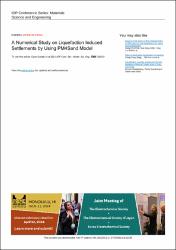| dc.contributor.author | Koltuk, Serdar | |
| dc.contributor.author | Subaşı, Ozan | |
| dc.contributor.author | Akbaş, Merve | |
| dc.contributor.author | Iyisan, Recep | |
| dc.date.accessioned | 2024-03-27T12:46:11Z | |
| dc.date.available | 2024-03-27T12:46:11Z | |
| dc.date.issued | 2021 | en_US |
| dc.identifier.citation | Koltuk, S., Subaşı, O., Akbaş, M., Iyisan, R. (2021). A numerical study on liquefaction induced settlements by using PM4Sand model. 1203 (3), 1-10.IOP Conference Series: Materials Science and Engineering. | en_US |
| dc.identifier.issn | 1757-8981 | |
| dc.identifier.uri | https://hdl.handle.net/20.500.12846/941 | |
| dc.description.abstract | The destructive effects of earthquakes negatively affect many people's lives
and cause a large number of lives and property losses. One of the most crucial factors that
increase the destructive effects and structural damages of earthquakes is the deformations in the
soil layers during strong ground motion. Especially liquefaction due to sudden increase in pore
water pressure during strong ground motion in saturated sandy soils causes large deformations
in the soil layers; hence leads to severe damage to the structures. Therefore, it is necessary to
determine the liquefaction-induced deformations and settlements in the soil layers with high
liquefaction potential. Following this purpose, three different two-dimensional fully saturated
soil profiles with 35, 55, 75 % relative densities were created and carried out by using different
strong ground motions for estimation of liquefaction-induced free field settlements. The finite
element code "Plaxis 2D" and constitutive model "PM4Sand" were used in the analysis. The
results of finite element (FE) analyses were compared with semi-empirical methods in the
literature. The liquefaction state observed with pore pressure ratio (Ru) and safety factor (FS) is
similar in numerical and empirical methods. The FE analyses have shown that the evaluation of
free-field, liquefaction-induced settlements obtained from PM4Sand-Model have considerably
lower settlement values than the semi-empirical methods. However, the semi-empirical method
suggested by Cetin et al. (2009) and numerical analyses gave quite similar settlement results to
each other. Moreover, there is no direct relationship between the liquefaction-induced
settlements and the earthquake source properties in the numerical method. However, this is
different for semi-empirical methods, and there is a relationship between strong ground motion
features and liquefaction-induced settlements. | en_US |
| dc.language.iso | eng | en_US |
| dc.relation.isversionof | 10.1088/1757-899X/1203/3/032029 | en_US |
| dc.rights | info:eu-repo/semantics/openAccess | en_US |
| dc.title | A numerical study on liquefaction induced settlements by using PM4Sand model | en_US |
| dc.type | article | en_US |
| dc.relation.journal | IOP Conference Series: Materials Science and Engineering | en_US |
| dc.contributor.authorID | 0000-0001-6931-0590 | en_US |
| dc.identifier.volume | 1203 | en_US |
| dc.identifier.issue | 3 | en_US |
| dc.relation.publicationcategory | Makale - Uluslararası Hakemli Dergi - Kurum Öğretim Elemanı | en_US |
| dc.contributor.department | TAÜ, Mühendislik Fakültesi, İnşaat Mühendisliği Bölümü | en_US |
| dc.identifier.startpage | 1 | en_US |
| dc.identifier.endpage | 10 | en_US |

















